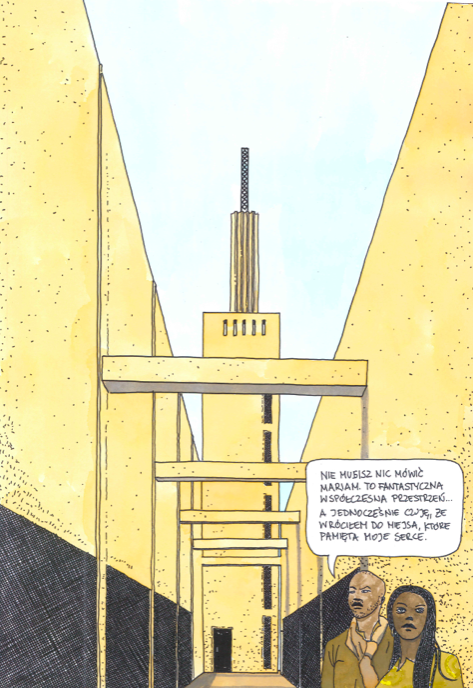Architect makes comic book inspired by atelier masōmī
A page depicting one of the scenes in Paweł Paradowski’s comic book.
Polish architect and urban planner Paweł Paradowski has been working on projects in places like Ghana and the DRC for a number of years. But his passion, when not working or travelling, is comic books. During a workshop in his hometown of Warsaw, he had to create his own fictional comic book story (in Polish) based on someone who inspired him. He decided to use it as an opportunity to combine all his passions of travelling to different West African countries and sustainable architecture and picked Mariam Kamara as the heroine in his fictional comic book. “For two years I have been working on a project to expand the city of Kalemie in DRC. It is an ambitious project in which I have to deal with many problems faced by the inhabitants. For this reason, I have been looking for inspiration from what is being created on the continent. This is how I found out about Mariam Kamara and atelier masōmī’,“ Paradowski says.
Paweł Paradowski’s drawing of Mariam Kamara and Sir David Adjaye
“Every year, comic book workshops are held in my city, Warsaw, devoted to personalities who have a great influence on the fate of various African countries and the world. This year, I was able to participate in it and I knew immediately who would be the heroine of my comic. The workshops are run by the Kultura Otwartości foundation and the mentor is Berenika Kołomycka, a great comic book artist.”
Paradowski says the story he came up with is loosely based on how he imagined Kamara and Sir David Adjaye meeting. While they met through the Rolex Mentorship programme in real life, in Paradowski ‘s comic book tale they meet in Niger where Kamara proceeds to show him around projects like the Dandaji Market and Hikma Religious and Secular Complex. “It is accompanied by drawings showing both the traditional architecture in Niger and the community functioning in the implemented design. The dialogues contained in them are ordinary conversations of the inhabitants. They relate to politics, sports or flirting (a young boy and girl in the library). At the end of the comic, we meet Mariam. On this drawing David compliments her work with words that I also made up.” He says the result of the workshops will be this story being included in a booklet containing the participants' works. He added: “It is published in Polish and available in my country at various African events”.


